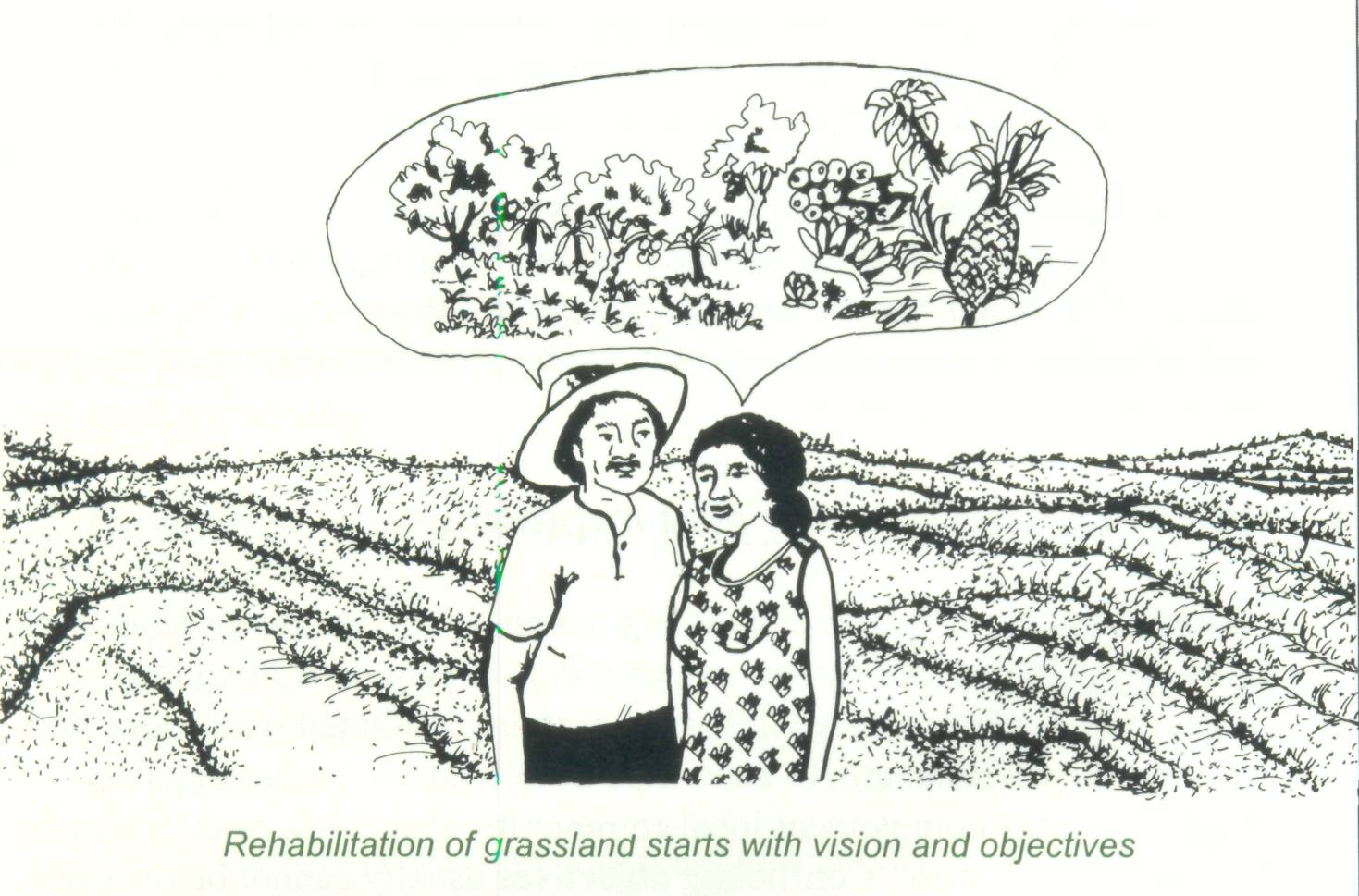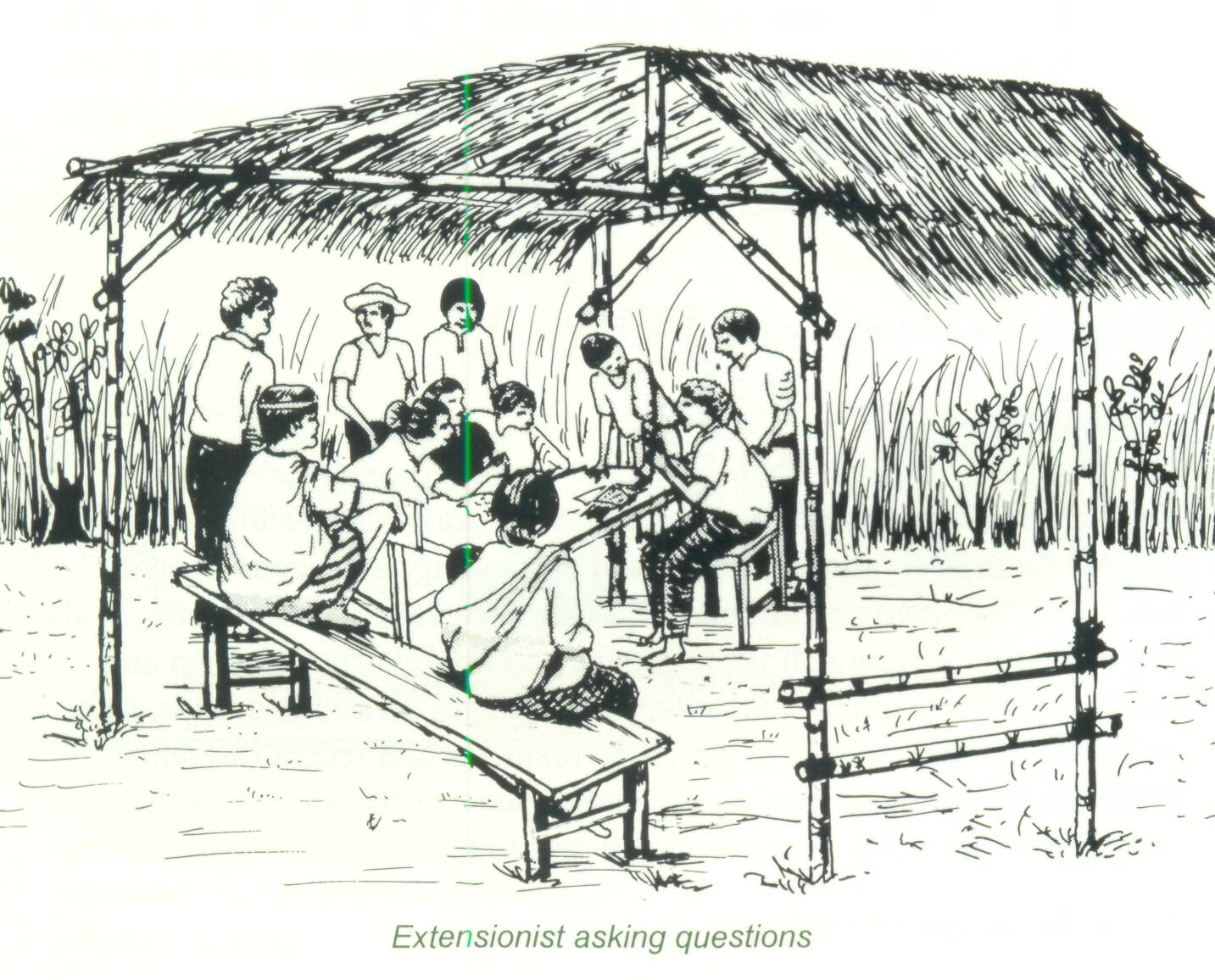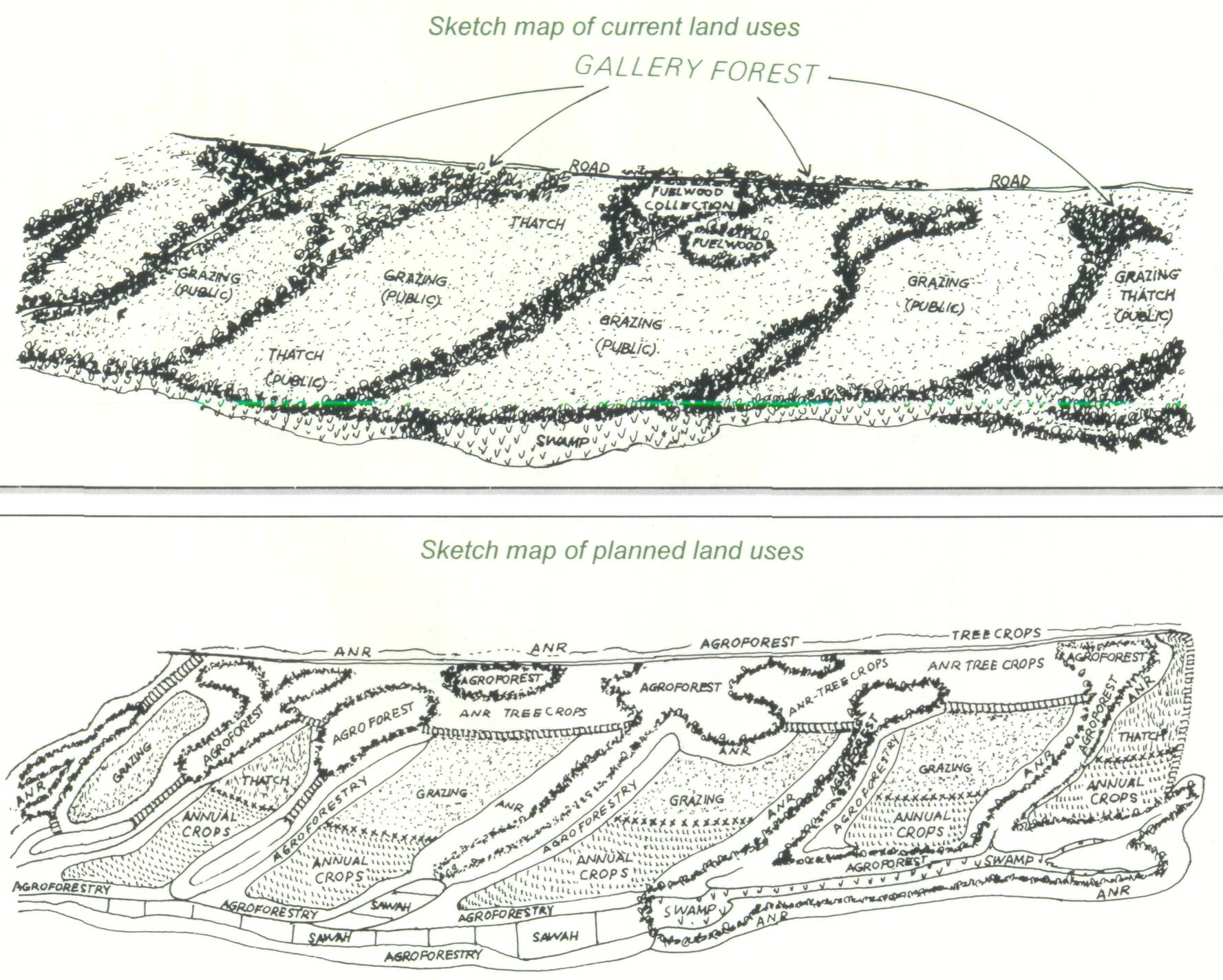|
Community development should
begin with local community objectives. However, national or regional
governments or programs often have objectives for Imperata
rehabilitation that are combined with watershed restoration,
resettlement, or economic development. These regional objectives may
complement local community objectives, or they may be in conflict with
them. Conflicting objectives usually cannot be resolved by just
educating the community, but require dialog and respectful negotiation.
Project managers and extension agents serve both regional programs
and local communities. They can help communities to explain their needs
to programs and governments. They can try to adjust outside assistance
to meet the objectives of local communities as much as possible. Or,
they can choose only communities that are good matches for the
development activities.
-
1.3.1 Role of the extensionist
Extensionists are the critical link in the chain between farmers and
research institutions, development organizations, and government
offices. Especially in Imperata grassland rehabilitation, the
extensionist should not just give farmers technical instructions.
An effective extensionist listens and learns. Often, only local
people can explain the history of an Imperata grassland and what land
claims and land uses exist.

...is sensitive. Farmers have constraints and limitations,
like insecure tenure or lack of resources. These constraints may keep
them from carrying out recommended activities. Their reluctance may be
perfectly rational. It may be the recommendations that need to be
changed.
...recognizes farmers' abilities. Farmers are often creative
experimenters. The extensionist should encourage them to establish
small trials of variations on technical recommendations. Farmers with
small plots can manage their land in a more complex way than large
plantations. They can select and plant a mixture of multipurpose trees
or specialty crops that grow in specific microsites or planting
spaces. Such intensive development of the land leaves less Imperata as
a fire hazard.
...helps the community with its objectives. The
extensionist's work should serve community needs and objectives. In
addition, short-term help with even small or unrelated objectives will
build the community support and trust needed to address long-term or
regional objectives.
...enables and empowers the community. Within the community,
the extensionist should encourage self-help groups to develop
cooperation and leadership in the community. The community should be
prepared to continue its activities even if the extensionist or
outside funding leaves. Communities in Imperata-dominated areas are
often remote and isolated. The extensionist can help overcome this
isolation by introducing community leaders to government agencies and
other sources of long-term assistance.
...is patient and has a sense of humor!
-
1.3.2 Community perspectives
Before launching any activities in Imperata grassland rehabilitation,
outside facilitators should understand community perspectives on all
ways that Imperata and alternative land uses affect the community.
Talk to people representing all those groups potentially affected: men
and women, people from various villages, people of all ethnic groups,
rich and poor, young and old, long-settled residents and recent
migrants, landowners and those owning no land. Often it is the least
prominent people who are most dependent on forest and grassland
resources.
Cover the following topics:
-
History of the grasslands. When did these
grasslands come into ' being? How have they been used in the past?
Have they been continuously maintained as grasslands?
-
Use of Imperata and Imperata grasslands.
Is Imperata used for thatch, medicine, rituals, fodder, or other
things? Are Imperata grasslands used for shifting agriculture, hunting
grounds, pasture, or thatch production? Are there people who depend
upon the Imperata resource for jobs? (For example, people may earn
money by plowing Imperata fields, or by thatching roofs.)
-
Changes in Imperata grassland use. Can
community elders remember these uses having changed during their
lives? How has Imperata use been affected by changes in population,
markets, technology, government pressure, or other events?

-
Rules for grassland use rights. What are the
current laws, regulations, and local customs controlling use rights
for these grasslands? How have these rules changed or evolved from
past traditions? How might an Imperata grassland rehabilitation effort
change these rules, for example by changing land tenure or use rights?
-
Differences within the community. Who uses
Imperata! Who claims Imperata grasslands? Are there differences
between how different groups (ethnic groups, men/women, old/young,
rich/poor, etc.) use or own it? How would changes brought about by
Imperata grassland rehabilitation affect these groups?
-
Local value of Imperata. Do local people
value Imperata and Imperata grasslands? How does that value compare
with the value of forest, forest plantations, other secondary
vegetation, agroforestry and crops? Where do farmers prefer to plant
their crops?
-
Productivity and environmental sustainability.
Are current land use practices productive? Do they cause environmental
problems? Will they continue to be productive in the long term? Do
local farming practices affect primary forest, old fallows, or
grasslands? Is soil erosion significant? Does the threat of fire
prevent investment in valuable crops?
-
Farmers' objectives. What are the farmers'
plans or suggestions for improvement of the Imperata grasslands or of
their farming practices? What changes do they think would benefit
their households or the community?
-
Agroforestry or Assisted Natural Regeneration.
Can agroforestry or ANR make the improvements suggested? What kind of
agroforestry or ANR practices? What species of trees, shrubs or crops
do farmers want to plant?
-
1.3.3 Community mapping and planning
Encourage local people to engage in a participative exercise to make
maps of the community and prospective land uses. This encourages
sharing of information and discussing objectives. The maps become a
focus around which the community begins to make decisions and plans.
Start with a map or maps describing the current situation:
Land ownership and claims. Map any large claims on forest and
agricultural areas. Elicit detailed information about claims on
Imperata grasslands.

Existing vegetation types. Map the large areas of primary forest,
secondary forest, agroforestry, and agriculture in the community. Pay
particular attention to mapping the different kinds of lmperata
grasslands: pure Imperata, Imperata with scattered shrubs and patches of
forest, Imperata areas with scattered agricultural activities, sparse
Imperata on poor soil, etc.
Land use. Show detailed information on the various uses of Imperata
grasslands, for example, agricultural fallow, hunting, and grazing.
Special features. Include roads, streams, springs, hills, valleys,
and other natural landmarks.
Mark a copy of the map to show plans for future land use:
Sites where current uses will continue :for example, forest,
agroforestry, agriculture. Sites to remain in Imperata, for various reasons:
-
Imperata grasslands that the community wants
to retain, for hunting, grazing, or thatch. Imperata might be an
important source of forage for local communities' cattle and water
buffalo.
-
Imperata grasslands that are so remote, fire-prone
or infertile that it is not worth trying to rehabilitate them in the
near future.
Sites for conversion from Imperata to other land uses.
Identify the planned land uses, depending on characteristics of the site
and the priorities of the community:
-
agriculture
-
agroforestry
-
assisted natural regeneration
-
tree plantations
-
improved forage
Improvements planned, especially buildings,
roads, trails and water projects.
The community may identify only a small area of land for
Imperata grassland rehabilitation. This may suggest that
rehabilitation is not perceived to be a priority and that the
community may be better served by other efforts. Perhaps more land
would be desired for rehabilitation if there were better market access
or more secure land tenure. Or, perhaps the community has a "wait and
see" attitude, and success with a small area will motivate people to
try more later.
|



